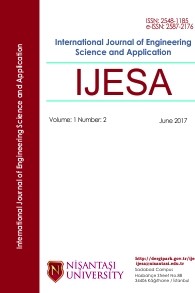ON THE STUDY OF THE COMPARATIVE ERROR BOUNDS OF HATA AND EGLI EMPIRICAL PREDICTION MODELS AT UHF BANDS IN EDO STATE
ON THE STUDY OF THE COMPARATIVE ERROR BOUNDS OF HATA AND EGLI EMPIRICAL PREDICTION MODELS AT UHF BANDS IN EDO STATE
Pathloss, Signal strength, Egli model Hata model,
___
- [1] Abhayawardhana V S, Wassel I J, Crosby D, Sellers M P, Brown M G. (2005). Comparison of Empirical Propagation Path Loss Models for Fixed Wirelwss Access Systems, 61st IEEE Technology Conference, Stockholm, 2005, Pp. 73 – 77.[2] Ogbeide K.O., Edeko F.O. (2014), Comparative Analysis of Empirical Path Loss Models for Signal Propagation in Urban Area of Edo State, Nigeria. International Journal of Engineering Innovation & Research. Volume 3, issue 3, ISSN:2277-5668. Page 339-341. [3] Govind S., Sonika S.(2014) A review on outdoor propagation models in radio communication, International Journal of Computer Engineering & Science, 2231–6590.[4] Egli, J. J.,(1957) “Radio propagation above 40 MC over irregular terrain,” Proceedings of the IRE, Vol. 45, No. 10, 1383–1391.[5] Mardeni R. and Kwan K.F. (2010) Optimization of Hata propagation prediction model in suburban area in Malaysia, Progress In Electromagnetics Research C, Vol. 13, 91–106.[6] Gupta V., Sharma S., (2009) Secure Path Loss Prediction in Fringe Areas Using Fuzzy Logic Approach, Advances in Computing, Control, & Telecommunication Technologies, 2009. ACT'09. International Conference on, IEEE. [7] Ogbeide K.O.and Anyanhun, I.A, (2017), Performance comparison of Okumura and Hata model for UHF signal propagation in the city of Warri, Nigeria, International journal of Engineering and Emerging scientific discovery (Online) Volume 12, number 1, pages 73-83. [8] Ogbeide K.O., Edeko F.O. (2013), Modification of the Hata Emperical Propagation Model for Application in the VHF Band in Edo State, Nigeria " International Journal of Engineering and Science Invention Volume 2, Issue 8, Pages 35-39.[9] Faruk, N., Adediran, Y.A., Ayeni A.A.,(2013) Error Bounds of Empirical Path Loss Models at VHF/UHF Bands in Kwara State, Nigeria IEEE Eurocon., 2013 (2013), pp. 602-607.[10] Faruk, N., Adediran, Y.A., Ayeni A.A.,(2013) On the study of empirical path loss models for accurate prediction of TV signal for secondary users Progr. Electromagn. Res. B, 49, pp. 155-176.[11] Thomas Z. Christian F., and Werner W. (2002).Stochastic Multipath Channel Model Including Path Directions for Indoor Environments, IEEE Journal on selected areas in communications, vol. 20, no. 6.[12] Yahia Z. (2014).Performance Analysis of Propagation Models for Cellular Mobile Communication Systems at 2.5 GHz International Journal of Scientific & Engineering Research, Volume 5, Issue 5, ISSN 2229-5518.[13] Hata, M. (1980). Empirical Formula for Propagation Loss in Land Mobile Radio Services. IEEE Transactions on Vehicular Technology.
- ISSN: 2548-1185
- Başlangıç: 2016
- Yayıncı: Nişantaşı Üniversitesi
ANGULAR DISTORTION IN BUTT ARC WELDING
Ahmet İrfan YÜKLER, Memduh KURTULMUS
EBUSSUUD PRIMARY SCHOOL RESTORATION PROJECT
Serdar KASAP, Şirin ARSLAN, Yavuz IRMAK
Speed optimization of 32 bit single precision floating point multiplier through pipelining in VHDL
An Innovative Fuzzy TOPSIS Method to Determine the Location of A New Hospital
